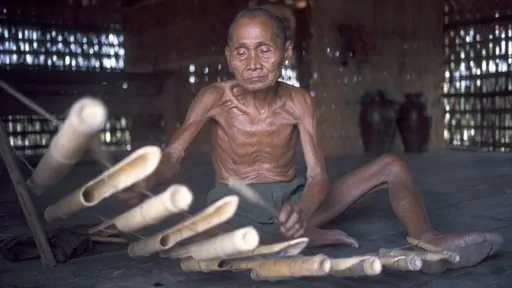Indigenous Calendar April, 2010: A Kachok Bamboo Xylophone and Ethnomusicology

I enjoy listening to music as much as I imagine anyone does. I even took the time as a teenager to learn something about the "family tree" of the kind of music I'd been exposed to. But it was much later in life that I developed a taste for what we now call "world music." Researching that topic I remember coming across the term 'ethnomusicology' and wondering what it might mean. When I learned what it meant — broadly the study of music within its social and cultural anthropological context — I remember wondering how that could even be a field of study unto itself.
All of this wondering happened, though, before I ever experienced music within what I could call its social and cultural anthropological context. My reaction then was to wonder if it could ever be a field fully studied.
I am not and have no desire to become an ethnomusicologist. In fact I have never visited any indigenous community specifically to witness or photograph events in which music plays a key role. But I have been fortunate enough to find myself in many situations where the music I was listening to added an element that, if missing, would have made my experience very different.
Ratanakiri Province in northeastern Cambodia is home to many indigenous peoples. I had flown to the provincial capital, Ban Lung. Small and isolated, Ban Lung is only the starting place of the adventure when visiting any of these peoples.
With my guide, I had first traveled for a few hours on dirt roads by motorbike. We had then been taken across a small river by the local boatsman. We drove the motorbike as far as we could until the local plantation had grown too thick to navigate safely any further. My guide announced that we would have to walk the remaining few kilometers to the first village we were to visit that day.
It was a tiny Kachok village of less than fifty inhabitants. As we walked through the village we visited each house. I think it was in the third or fourth house that the family were about to prepare lunch. My guide knew to bring our own food into the village — we had a bag of rice, a few vegetables and a couple of large, fresh fish we'd bought in the riverside village as we'd crossed the river. At my suggestion, we agreed to pool our food and share a communal meal. As it usually does, this act broke the ice for me in this village.
Toward the end of that meal I began hearing what sounded like a xylophone. Since the village had no electricity, and didn't look prosperous enough for anyone to afford consumer electronics, it had to be a live performance. But how could there be a xylophone out here in the middle of nowhere, I wondered. When the eating was over I asked my guide about it. He explained that it was being played as a simple and common pastime and seemed confused at my high interest level. We found the house where it — whatever it was — was being played. We entered to find this man playing away contentedly like a child with a new birthday present. The "xylophone" was similar to a xylophone. It was made from bamboo stalks, each being hand-carved to tune it to a scale that I didn't recognize.
The man was in his late seventies and had learned to play from his father who in turn had learned to play from his father and so on, I can only assume, back to the time when the Kachok first invented this instrument. He explained that he had been told of my arrival in his village and was playing to offer his welcome to me. Touched by this, I asked him if he had taught any of the young boys in the village to play. Some had shown interest, he responded, but none had practiced enough to be able to play it correctly. He appeared to be saddened by this and I couldn't help feeling saddened also by the knowledge that I was witnessing, as I have many times, a small part of the disappearance of culture.
The Kachok are featured in our documentary, Indigenous Peoples of Southeast Asia.
If you enjoyed reading this article, please consider supporting independent, advertising-free journalism by buying us a coffee to help us cover the cost of hosting our web site. Please click on the link or scan the QR code. Thanks!


